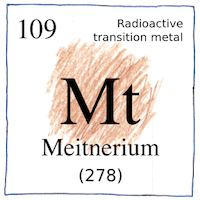Meitnerium
In 1982, the team at Darmstadt synthesized one atom of meitnerium-266 by bombarding bismuth-209 with iron-58 nuclei. The new atom lasted only a moment then decayed into an atom of bohrium-262.
Atomic number 109
The chemistry of meitnerium, like the chemistries of other superheavy elements, has been predicted based on the properties of the elements above it in the periodic table; possibly like iridium, rhodium, and cobalt, possibly a noble metal in the platinum group; however, meitnerium is the lightest element whose chemistry has not been tested.
Hypothetical metal
It would be a heavy metal but the longest-lived isotope has a half-life of 7.6 seconds. Creating and keeping enough of it would be impractical or impossible. * I would be worth my weight in gold if I were sufficiently practical. I would be strong as John Bunyan if I didn’t dislike exercise.




The math for the production and decay of the first meitnerium is simple arithmetic. Bismuth-209 plus iron-58 minus one neutron equals meitnerium-266. Meitnerium-266 minus one alpha emission is bohrium-262, since an alpha emission is one helium nucleus (two protons and two neutrons).
See also in The book of science:
Readings in wikipedia:
Other readings: